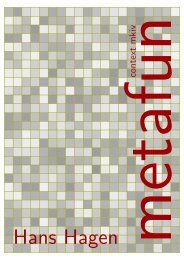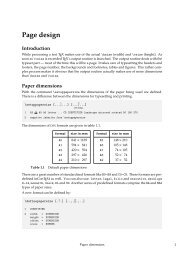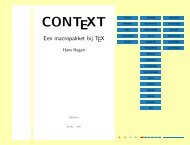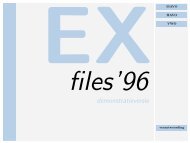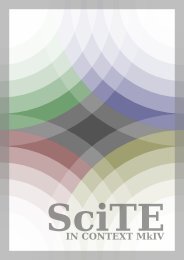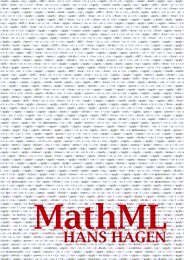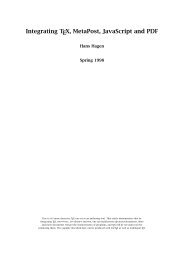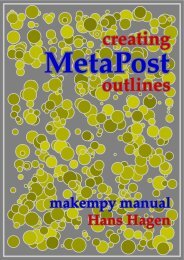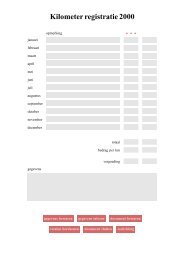Hagen - Pragma ADE
Hagen - Pragma ADE
Hagen - Pragma ADE
Create successful ePaper yourself
Turn your PDF publications into a flip-book with our unique Google optimized e-Paper software.
58<br />
Features<br />
in base mode. A single substitution is just another instance of a glyph so there we just<br />
replace the original index into the glyph table by another one. In the case of an alternate<br />
we change the default index into one of several possible replacements in the alternate<br />
set. Ligatures can be mapped onto T E Xs ligature mechanism. The single positioning<br />
maps nicely on T E Xs kerning mechanism and pairwise positioning is not applicable in<br />
base mode. In node mode we don’t do any remapping at loading time but delegate that<br />
to Lua when processing the node lists.<br />
Marks are special in the sense that they normally only occur in scripts that also use<br />
substitution and positioning which in turn means that some more housekeeping is involved.<br />
After all, we need to keep track to what a mark applies. Of course a font can<br />
provide regular latin accents as marks but that is ill practice because cut and paste<br />
might not work out as expected. A proper font will support composed characters and<br />
provide glyphs that have the accents built in. Marks are not dealt with in base mode.<br />
Talking of complex scripts, the above set of operations is far from enough. Take for<br />
instance Arabic, where a sequence of 5 characters with 3 marks can easily become<br />
two glyphs glued together with two marks only. In the process we can have single<br />
substitutions, ligatures being built, marks being anchored and glyphs being cursively<br />
positioned. But, in order to do this well, some contextual analysis has to be done as<br />
well. Again we have several variants of this:<br />
• with contextual substitution a replacement takes place depending on a matching sequence<br />
of glyphs, optionally preceded or followed by matches<br />
• with contextual positioning shifting and anchoring happens based on a matching sequence<br />
of glyphs, optionally preceded or followed by matches<br />
• multiple contextual substitutions or positionings can be chained together<br />
• this can also happen in the reverse order (for right-to-left scripts)<br />
In practice there is no fundamental difference between these and we can collapse<br />
them all in a sequence of lookups resulting in a sequence of whatever other manipulation<br />
is wanted.<br />
Given this, what is a feature? It’s mostly a sequence of actions expressed in the<br />
above. And although there is a whole repertoire of semi-standardized features like liga<br />
and onum, there is no real hard coded support for them in ConT E Xt. Instead we have a<br />
generic feature processor that deals with all of them. A feature, say abcd, has a definition<br />
that boils down to a sequence of lookups. A lookup is just a name that is associated to<br />
one of the mentioned actions. So, abcd can do a decomposition (multiple substitution),<br />
then a replacement (single substitution) based on neighbouring glyphs, then do some<br />
ligature building (ligature substitution) and finally position the resulting glyphs relative<br />
to each other (like cursive positioning and anchoring marks).<br />
Imagine that we start out with 5 characters in the input. Instead of real glyphs we<br />
represent them by rectangles. The third one is a mark.



